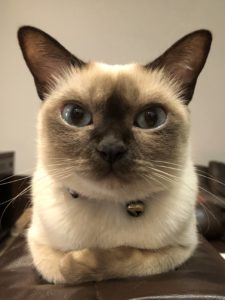Cats With Pancreatitis–The Road To Recovery
The feline pancreatitis roller coaster
If you’ve ever had a cat that developed pancreatitis my heart goes out to you. It’s one of the most common health issues many of my clients and followers contact me about. There’s even a Facebook group called Cats With Pancreatitis, so clearly it’s a serious and quite common ailment that leaves many cat parents at a loss–both financially and emotionally.
My own personal experience began many years ago when my own cat, Hershey, developed pancreatitis out of the blue. It resulted in several more episodes every few weeks, several vet visits, and medication for nausea and antibiotics. When the vet could do no more to help he recommended I go see a specialist. In my heart I knew there was a better way than being on medication for the rest of his life–determine and treat the cause not the symptoms.
The conventional medicine approach
The most common plan of “treatment” by the veterinary community is to prescribe something for pain, Cerenia for nausea, and perhaps an antibiotic for the elevated white blood cell count. If the case is severe enough fluid therapy with hospitalization is required. While I truly believe there is a time and place for conventional treatment, recurring bouts of pancreatitis can put your cat on a vicious cycle of repeating these steps over and over again. Flare ups can get worse and more frequent over time. Therefore, consider some alternative and holistic ways to address this painful condition.
Cats with pancreatitis need to change their diet
There are several reasons why cats develop pancreatitis, including trauma to the pancreas, pesticides, parasites, and even certain pharmaceutical drugs.
Karen Becker, DVM, finds that most cases of feline pancreatitis can be traced back to diet: eating food with ingredients that promote GI tract inflammation. “Most commercial cat foods contain allergenic ingredients that your kitty’s GI tract objects to over time. And if you’re feeding him the same food day after day, year in and year out, he’s probably developed an allergy to the protein source in the food as well.Since one of the jobs of the pancreas is to aid digestion, when your pet’s GI tract becomes inflamed and starts to falter, the pancreas can become stressed from working too hard to produce a sufficient amount of digestive enzymes for use by the intestines.”
Eliminate the kibble
Most cats eat a processed food diet (kibble) which is loaded with carbohydrates (corn, wheat, peas, legumes, lentils, rice, potatoes). The pancreas doesn’t produce enough enzymes that help break it down during digestion. Processed food also requires high levels of insulin which is also produced by the pancreas. The result is chronic inflammation and pancreatic stress which leads to pancreatitis.
Other causes of feline pancreatitis
According to Lorelei Whitney in Veterinary Homeopathy: Fast Forward To The Cure, there are other causes to consider.
Bacteria and other infectious agents can cause pancreatitis. Bacteria are common in many commercial dry
pet foods and their numbers can increase after food is moistened. Bacteria can reflux from the intestine through the pancreatic duct and into the pancreas. They can also cross the intestinal wall and into the pancreas lying adjacent.Animals with acute pancreatitis have bacteremia and bacteria in the pancreas. Regardless of whether this is a primary or secondary phenomenon affected animal must be treated with antibiotics.
Commercial pet foods and foods contaminated by coliform bacteria contain endotoxin. Their consumption can result in endotoxemia. Endotoxemia is a feature of acute pancreatitis and contributes to the damage, partly because endotoxin disrupts pancreatic microcirculation.
In light of these facts, it’s highly recommended to provide your cat with a biologically appropriate diet. Offering a wet, meat-based diet, whether it be raw, lightly cooked, or human grade canned food, with little to no grains or carbohydrates, is the best way to avoid pancreatitis to begin with.
Symptoms to look for
Cats who are experiencing a pancreatitis flare up may exhibit the following symptoms:
- Very lethargic, sleeping a lot
- Lack of appetite
- Fever
- Tenderness or pain around the abdomen
It’s very easy for a cat to get dehydrated if he’s vomiting a lot, so you need be vigilant. In acute cases IV fluid therapy is essential; without it mortality rates can be high. Severe flare ups can also produce elevated liver enzymes (ALT), and going for more than couple of days without food can put a cat at risk for developing fatty liver disease (hepatic lipidosis), which can be deadly. Don’t wait too long to seek medical attention!
Cats whose condition is not as severe can be managed at home. Keep in mind–skipping a meal or two is actually necessary in order to let the pancreas “calm down.” Feeding actually stimulates the pancreas to secrete, worsening the condition. This is why a cat knows instinctively not to eat whenever the pancreas is inflamed. When your cat starts to show an interest in some type of food or treat you’ll know things are calming down.
How to work through pancreatitis without drugs
Getting your cat through a flare up can be extremely tricky. You have to be extremely patient and persistent because your cat won’t always be ready to cooperate despite your good intentions. A cat’s normal appetite may not come back right away, and the regular food may not be appealing yet, so what can you do in the meantime? There are several things you can try in the transition from a flare up back to normal. Your cat’s body knows exactly which option resonates with it and which will be most effective. Muscle testing or energy testing is the way to find out.
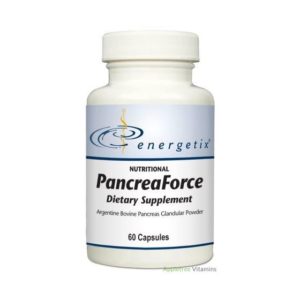 PancreaForce by Energetix.
PancreaForce by Energetix.
Yes, it’s designed for humans, but you can adjust the dosage for your cat. “PancreaForce is a pure, clean source of bovine pancreas glandular. It is full of enzymes, B vitamins, and minerals including zinc and chromium. This lyophilized pancreatic glandular tissue concentrate complex helps maintain normal blood sugar levels and pancreatic function.” Give 1/4-1/2 capsule twice a day for 2-3 days at the first sign of symptoms. If your cat likes baby food (ie: Gerber Chicken and Gravy) mix it in the food and offer it as a treat. Or you can mix it with a small amount of water and use a syringe to squirt in the cat’s mouth. Hershey’s pancreatitis would clear up in a day or two of using this product.
Baby Food Meat
If your cat isn’t ready to eat his regular food just yet, try offering baby food meat as a treat. My cats like Gerber. I use it as a “transition” food once the flare up is subsiding. Hershey would often just eat a jar of baby food for a day or so and then start eating his regular food again.
Kefir
Raw kefir is loaded with nutrients and probiotics and great for digestion and gut health. You can find this in most grocery stores these days in the dairy section. Be sure to get the plain, unsweetened kind. You can offer a tablespoon on a spoon or in a bowl once or twice a day.
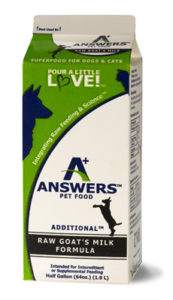
Answers Pet Food Additional Formula, Raw Goat’s Milk Formula
Raw Goat’s Milk
Raw goat’s milk that has been fermented makes it a great superfood for your cat. It contains an extensive list of naturally-occurring vitamins, minerals, probiotics, enzymes, and fatty acids. Try offering a tablespoon once or twice a day until you cat shows an interest in regular food.
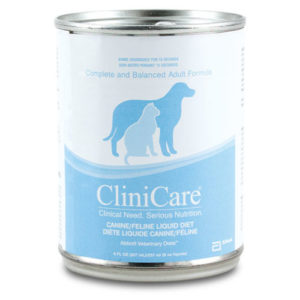 CliniCare Liquid Diet
CliniCare Liquid Diet
CliniCare liquid diets are often available at vet clinics, and are great to use for a couple of days as your cat transitions back to its normal food. While it does contain a small amount of soybean and canola oils, the total fat content is 5%, which is ideal. Using it on a very short term basis is safe, and it’s easy to administer via syringe.
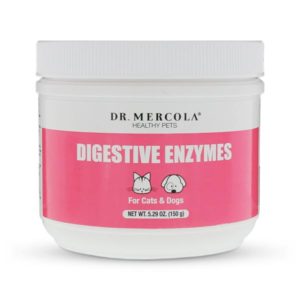 Digestive Enzymes
Digestive Enzymes
For cats who have gone through pancreatitis I highly recommend using digestive enzymes mixed into their food. They help the pancreas break down the food without over-stressing it and aid in digestion. Once your cat has transitioned on to a meat-based diet without grains and carbs there’s a good chance he won’t need to continue the digestive enzymes. Hershey used digestive enzymes in all his meals for several months after he developed pancreatitis. After he successfully transitioned on to a wet diet without carbs he needed the enzymes less and less until finally he didn’t need them at all!
Homeopathy
Using a homeopathic remedy can be quite effective in eliminating the flare up. Traditionally a remedy is selected by observing symptoms that match up with it. In Veterinary Homeopathy: Fast Forward To The Cure there are several remedies that treat pancreatitis in pets.
- Iris versicolor 30c–one of the most important remedies when symptoms include severe abdominal pain, vomiting of bile, stools become watery and can be green in color.
- Atropinum 6c–best used when vomiting relieves symptoms and the umbilical area is extremely sensitive to touch
- Chionanthus 6c–best used when there is severe abdominal pain accompanied by liver problems
- Iodum 6c–best used when there is a voracious appetite, the animal is exceedingly thin with enlarged lymphatic glands and craves cold air
Flower Essence Formula
Whenever one of my cats has been sick I always pull out a flower essence formula called Magenta Self Healer by FES Flowers. This gentle yet powerful flower essence encourages self-healing potential and physical vitality by boosting the combined immune forces of both the body and spirit. You simply spray some onto your hands and pet your kitty all over, including the face and ears, three to four times per day until a full recovery is made.
Not all the symptoms always align exactly, so muscle testing is the key to know if and which remedy is best suited for your cat. Be patient and realize it takes time for the cat’s pancreas to heal and return to normal function. The cycle of flare ups and treating symptoms without a change in diet can often perpetuate itself with episodes growing worse over time.

